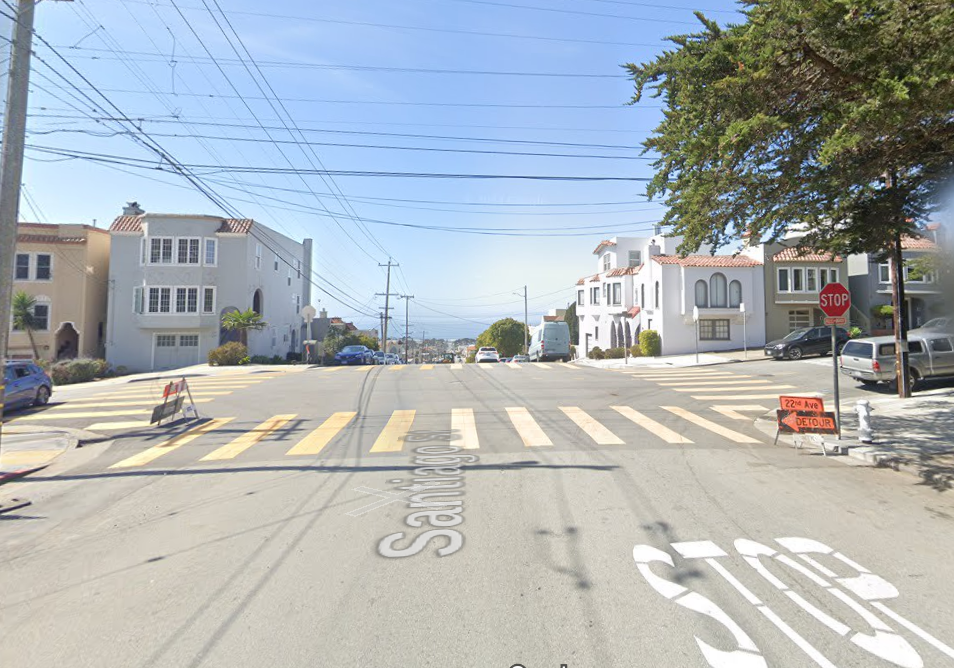The following is a statement from Walk San Francisco about the two most recent traffic violence tragedies in the city.
In two separate crashes within days in the Sunset neighborhood, two pedestrians were killed. On Monday, Huansu He was struck and killed while crossing at 24th Avenue and Santiago Street.
On Saturday, October 22, a senior female pedestrian was hit at 19th Avenue and Buckingham Way, and succumbed to her injuries on Monday. In total, 16 people have been killed while walking in San Francisco this year. 29 people have been killed in all traffic crashes this year, which is more than all of 2021. In under 10 months, 2022 has already exceeded the number of people killed on city streets last year.
“Our hearts go out to these two families suffering unimaginable loss,” said Jodie Medeiros, executive director of Walk San Francisco.
Walk San Francisco and the San Francisco Bay Area Families for Safe Streets community stand ready to support the friends and loved ones of the victim however possible.
“We face more threats than ever when walking,” said Medeiros. “The pandemic unleashed even more aggressive driving, especially dangerous speeding. And too many streets are still designed to prioritize moving traffic quickly instead of prioritizing people’s safety.”
“It shouldn’t be like this. Traffic safety needs to be a top priority for our city leaders, because too much is at stake when streets are unsafe,” said Medeiros. “We need streets to be designed and enforced to protect everyone, especially seniors and kids.”
Medeiros also pointed out that Measure L on the November 8 ballot is directly related to pedestrian safety improvements. “Voters should know that if Measure L doesn’t pass, the City’s primary source of funds to make streets safer will go away,” said Medeiros. “If voters don’t pass Measure L, desperately-needed projects to protect people in the crosswalk and reduce deadly speeds will not happen.”
Measure L continues San Francisco’s ½ cent sales tax for transportation. This has been a core funding source for public transit (including Muni, BART, Caltrain, ferries, and paratransit) and street projects (including redesigning some of the most dangerous streets) for more than 30 years!
The intersection where Huansu He was fatally hit – 24th and Santiago – highlights the need to address the super wide streets where dangerous speeds are commonplace. Santiago has two lanes of parking and two travel lanes, but is far too wide (50 ft) for these few lanes.
Santiago could use any number of improvements that require drivers to slow down: traffic circles at intersections to force slower intersection speeds, or chicanes, median islands, or pinch points that narrow the street and require more precise driving. Speed humps would be especially important to add by the school and park on Santiago. And there are many streets that fit Santiago’s profile, which are ripe for crashes.
“We need San Francisco to prioritize people, not fast-moving traffic, on our streets,” said Medeiros. “That means harnessing every possible strategy to bring down speeds, plus doing everything possible to make people safer in the crosswalk.”
Citywide, around 30 people are killed and more than 500 severely injured each year on San Francisco streets. Older adults make up 50% of these fatalities annually.
Huansu He’s family has set up a GoFundMe, which includes more details about this beloved mother and grandmother. At World Day of Remembrance for Road Traffic Victims on Sunday, November 20 at City Hall, Huansu He and all of those who have been killed in traffic crashes in San Francisco will be remembered.
Supervisor Gordon Mar, whose district is the Sunset, along with the SFMTA and SFPD will be holding a community meeting to discuss these crashes, and traffic safety in the Sunset on Monday, October 31 at 5pm at the Taraval Police Station community room.
Walk San Francisco and San Francisco Bay Area Families for Safe Streets are also calling on city leaders to prioritize traffic safety and take bold actions. This includes:
- Complete at least 20 Vision Zero Quick Build projects each year (including 2022) so that all 160 miles of high-injury streets have had meaningful safety fixes by 2024. This is the commitment the City made in its new Vision Zero Action Strategy, and it cannot fall behind on this essential goal.
- Lower speed limits to 20 MPH on the 35 identified eligible business corridors citywide, plus complete the evaluation for eligibility of the miles of streets in the Financial District, SoMa, Mission Bay, North Beach, Fisherman’s Wharf, and Chinatown by December 31. Speed continues to be the #1 cause of severe and fatal crashes in San Francisco – and bringing down speeds is the fastest way to save lives.
- Expedite and expand the use of left turn calming, no-turn-on-red, and pedestrian safety zones throughout the high-injury network. These low-cost solutions are proven to keep us safer in the crosswalk.
In 2021, the State Assembly passed Assembly Bill 43, which allows speed limits to be set based on safety on certain types of streets. San Francisco has used this new legal authority to reduce speed limits to 20 MPH on 15 streets so far with another 8 in progress. Learn more about AB 43.
In 2014, 13 City agencies committed to Vision Zero: a comprehensive, data-based, preventative approach to ending severe and fatal crashes by 2024. The most recent Vision Zero Action Strategy and Walk San Francisco’s analysis of it can be viewed here.
***
Marta Lindsey is Communications Director with Walk San Francisco






